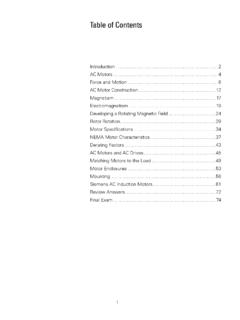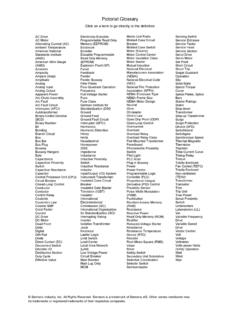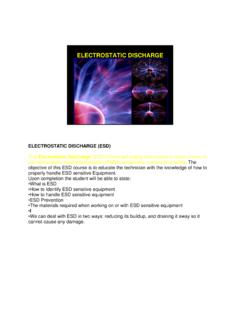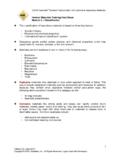Transcription of Basics of Electricity-Introduction - sitrain.us
1 Basics of electricity A quickSTEP Online Course Siemens industry, Inc. Trademarks Siemens is a trademark of Siemens AG. Product names mentioned may be trademarks or registered trademarks of their respective companies. Other trademarks are the property of their respective owners. Siemens Industry, Inc. 2016 Page 2. Course Topics Welcome to Basics of electricity . This course covers the following topics: Introduction Chapter 1 Direct Current Direct Current Basics DC Circuits Magnetism Chapter 2 Alternating Current Alternating Current Basics Inductance and Capacitance AC Circuits Transformers Final Exam If you do not have a basic understanding of electricity , complete this course before starting other quickSTEP online courses.
2 Siemens Industry, Inc. 2016 Page 3. Course Objectives Upon completion of this course you will be able to . Explain the difference between conductors and insulators Use Ohm's Law to calculate current, voltage, and resistance Calculate equivalent resistance for series, parallel, or series-parallel circuits Calculate voltage drop across a resistor Calculate power given other basic values Identify factors that determine the strength and polarity of a current-carrying coil's magnetic field Determine peak, instantaneous, and effective values of an AC sine wave Define inductive reactance, capacitive reactance.
3 And impedance Calculate total impedance of a simple AC circuit Explain the difference between real power and apparent power in an AC circuit Determine how a transformer turns ratio affects secondary voltage and current Siemens Industry, Inc. 2016 Page 4. SITRAIN Training for Industry Online Self-paced Learning Programs with maximum flexibility so students can easily fit courses into their busy schedules Virtual Instructor-led Learning - Classroom lectures delivered in the convenience of your home or office Classroom Learning - Expert and professional instructors, proven courseware, and quality workstations combine for the most effective classroom experience possible at your facility or ours How-to Video Library - Quick, affordable.
4 Task-based learning options for a broad range of automation topics for training or purchase Simulators - World-class simulation systems available for training or purchase This course also describes learning options available from the Siemens SITRAIN USA organization and our global SITRAIN partners. For additional information: Siemens Industry, Inc. 2016 Page 5. Chapter 1 Direct Current This chapter covers the following topics: Direct Current Basics DC Circuits Magnetism Siemens Industry, Inc. 2016 Page 1-1. Atoms All matter is composed atoms. Atoms have a nucleus with electrons moving around it.
5 The nucleus is composed of protons and neutrons (not shown). In their neutral state, atoms have an equal number of electrons and protons. Electrons have a negative charge. Protons have a positive charge . Neutrons are neutral. The negative charge of the electrons is balanced by the positive charge of the protons. Electrons are bound in their orbit by their attraction to protons. Siemens Industry, Inc. 2016 Page 1-2. Free Electrons Electrons in the outer band can become free of their orbit by the application of some external force such as movement through a magnetic field, friction, or chemical action.
6 These are referred to as free electrons. A free electron leaves a void which can be filled by an electron forced out of orbit from another atom. As free electrons move from one atom to the next an electron flow is produced. This is the basis of electricity . Siemens Industry, Inc. 2016 Page 1-3. Conductors An electric current is produced when free electrons move from one atom to the next. Materials that permit many electrons to move freely are called conductors. Copper, gold, silver, and aluminum are examples of materials that are good conductors. Copper is widely used as a conductor because it is one of the best conductors and is relatively inexpensive.
7 Siemens Industry, Inc. 2016 Page 1-4. Insulators Materials that allow few free electrons are called insulators. Materials such as plastic, rubber, glass, mica, and ceramic are examples of materials that are good insulators. An electrical cable is one example of how conductors and insulators are used together. Electrons flow along a copper conductor in a circuit and the insulator around the outside of the copper conductor keeps electrons in the conductor. Siemens Industry, Inc. 2016 Page 1-5. Semiconductors Semiconductor materials, such as silicon, can be used to manufacture devices that have characteristics of both conductors and insulators.
8 Many semiconductor devices act like a conductor when an external force is applied in one direction and like an insulator when an external force is applied in the opposite direction. This principle is basic to the operation of transistors, diodes, and other solid-state electronic devices. Siemens Industry, Inc. 2016 Page 1-6. Electric Charges Elements are defined by the number of electrons in orbit around the nucleus of an atom and by the number of protons in the nucleus. A hydrogen atom, for example, has only one electron and one proton. An aluminum atom has 13 electrons and 13 protons.
9 An atom with an equal number of electrons and protons is said to be electrically neutral. Electrons in the outer band of an atom are easily displaced by the application of some external force. Electrons which are forced out of their orbits can result in a lack of electrons where they leave and an excess of electrons where they come to rest. A material with more protons than electrons has a net positive charge, and a material with more electrons than protons has a net negative charge. A positive or negative charge is caused by an absence or excess of electrons, because the number of protons in an atom remains constant.
10 Siemens Industry, Inc. 2016 Page 1-7. Attraction and Repulsion of Electric Charges The old saying, opposites attract, is true when dealing with electric charges. Charged bodies have an invisible electric field around them. When two unlike-charged bodies are brought together, their electric fields attract one body to the other. When two like-charged bodies are brought together, their electric fields repel one body from the other. During the 18th century a French scientist, Charles A. Coulomb, studied fields of force that surround charged bodies. Coulomb discovered that charged bodies attract or repel each other with a force that is directly proportional to the product of the charges and inversely proportional to the square of the distance between them.











